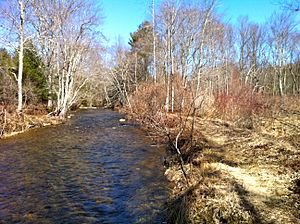Fenton River facts for kids
The Fenton River is an important river in Connecticut. It flows for almost 19 miles (about 30 kilometers) through towns like Mansfield, Storrs, and Willington. Most of the river is in Tolland County.
The Fenton River is a main water source for the University of Connecticut's Storrs Campus. Because of this, the river is usually quite shallow. Many smaller brooks and streams feed into the Fenton River. At its end, the river flows into the Mansfield Hollow reservoir. This makes it a part of the larger river system that includes the Mount Hope, Natchaug, and Willimantic rivers.
Along the river's banks, there are large areas of protected land. Much of this land belongs to the university, Joshua's Trust, or is part of the Nipmuck Trail. A historic stone Gristmill, once used for grinding grain, stands where Stonemill and Gurleyville roads meet. This old mill is now protected by Joshua's Trust. The USGS has a station on Old Turnpike Road in Storrs that checks the river's flow and height. Sometimes, the river is not used for water if there is a drought.
How the Fenton River Got Its Name
The Fenton River has an interesting story behind its name. People say it was named after a man called Francis "the Money Maker" Fenton. He was known for making fake silver coins.
One day, a police officer was chasing him. Francis Fenton cleverly hid at the bottom of the river, breathing through a hollow reed so he wouldn't be found. He was later arrested and brought to trial. However, the coins he made were Spanish dollars, which were foreign money. It turned out that his fake coins were actually made of pure silver! At that time, there was no law against making fake foreign money if it was pure silver. So, Francis Fenton was found not guilty and set free.
Animals of the Fenton River
The Fenton River is home to many different animals, just like other rivers in northeastern Connecticut. If you visit, you might see some amazing wildlife.
- Birds: You can often spot large Great blue herons standing in the water, looking for fish. Sometimes, though it's rare, you might even see a loon. People sometimes mistake loons for ducks.
- Mammals: On the river banks, you might see bobcats. Many other mammals also live in this area.
- Reptiles and Amphibians: Snapping turtles are common in the river. Many other reptiles and amphibians also make their home here.
- Insects: The river is a great place for insects to grow and reproduce. You'll find many dragonflies and other insects flying around.
- Fish: The Fenton River is a popular spot for fishing. Anglers (people who fish) often catch rainbow trout and salmon. Many of the trout are put into the river by the DEEP and the University of Connecticut to keep the fish population healthy.
Plants Along the Fenton River
The banks of the Fenton River are full of different kinds of plants and trees. The area has enough moisture and shade for many species to grow well.


